Menu

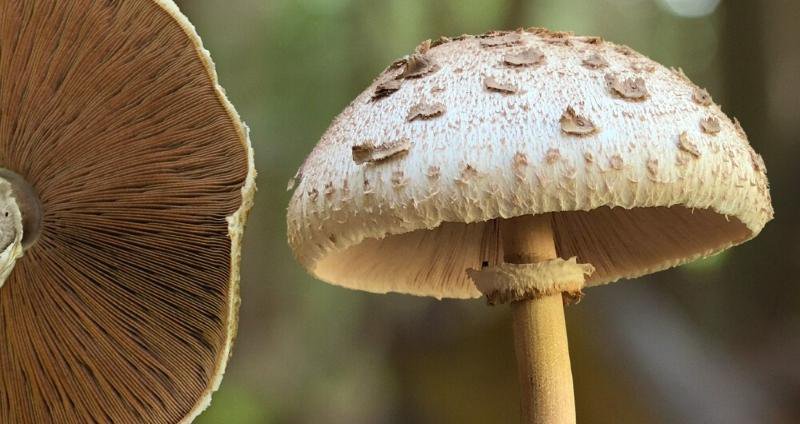
Have you ever stopped and asked yourself what the actual parts of a mushroom are? There’s much more to mushroom anatomy than what meets the eye – quite literally.
Mushrooms are not plants or animals but a collection of species that belong to the fungi kingdom. In addition, describing mushroom anatomy is not always easy because there are so many mushroom species with unique characteristics.
For example, the visible mushroom (fruiting body) that grows from the ground or tree shows only a small part of the fungi's anatomy. Beneath the surface, they have minuscule hyphae that make up mycelial networks that can spread out for miles.
If you’re curious about what makes a mushroom tick and wonder what parts are known to have different health benefits for humans, this guide has you covered.
Let’s take a look at the parts that make up a mushroom's anatomy, their functions, and health-supporting properties.
If you’d like to wrap your head around the basics of mushroom anatomy at a glance, having a general overview can help you visualize how each part interacts with each other.
Before we go into the details of the parts of a mushroom, here are some helpful diagrams you can look back on:
When you think of the parts of a mushroom, the image that comes to mind is likely the mushroom itself, also known as the fruiting body. It’s the part we cook in meals, see in pictures, or encounter when we go out in nature to spot wild mushrooms.
Besides the fruiting body, there’s also an essential part of a fungal organism hiding under the surface. The mycelium is like a plant’s root network that spreads over large distances underground to absorb nutrients and connect other fungi to each other.
The term “mushroom” is interchangeable with the term “fruiting body.”
Just as an apple is to a tree, the mushroom is the fruit of fungal organisms. When comparing it to fruiting plants, the mushroom is the “fruit” of the fungus.
Mushrooms (fruiting bodies) have four primary structures:
For most common fungi, the mushroom, which can also be called a sporophore, is made up of a cap and stem. It only exists for a short period, and its primary evolutionary function is to spread spores at the end of the mushroom’s life cycle.
Some of these spores will go on to produce new mushrooms and restart the cycle [1] [2].
Listed below are the different parts of a mushroom and their different attributes.
Mushroom caps can have a wide range of physical differences from one mushroom species to another. The common appearance of the mushroom anatomy that most people are familiar with consists of a cap and stem.
The mushroom cap, also known as the pileus, is the structure on top of the mushroom that holds the gills or pores. They come in different shapes, sizes, colors, and textures.
Know Your Mushrooms: Mushroom caps can be smooth or covered with scales or teeth. Since their shape is unique from species to species, doing research on specific mushroom species will be helpful for identification.
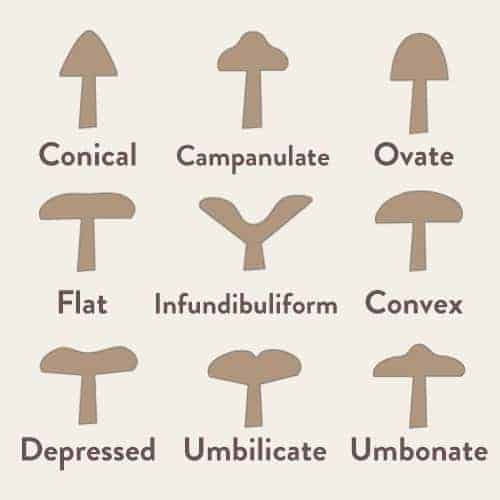
The familiar mushroom anatomy shape is somewhat spherical, like an umbrella. In the early stages of development, it can be evenly convex and then become more expanded as it matures.
Some common mushroom cap shapes include:
Many mushrooms, like some of our favorite functional mushrooms, have a very unique look.
Take lion's mane mushrooms, for instance. They are tooth fungi, meaning instead of a spherical dome cap, they have “teeth” or shaggy hair-like structures that hang around the mushroom and produce spores.
Scales are part of a mushroom's anatomy that form hard-shelled protection for fungi. They often appear in various shapes and sizes, contributing to the unique physical appearance of mushrooms in the wild.
Scales typically appear on the cap but can also be present on the stem. They often appear as the result of cracking as the cap expands during growth but can also be seen when immature.Scaly caps can also be useful in identifying mushrooms, as numerous species have them.
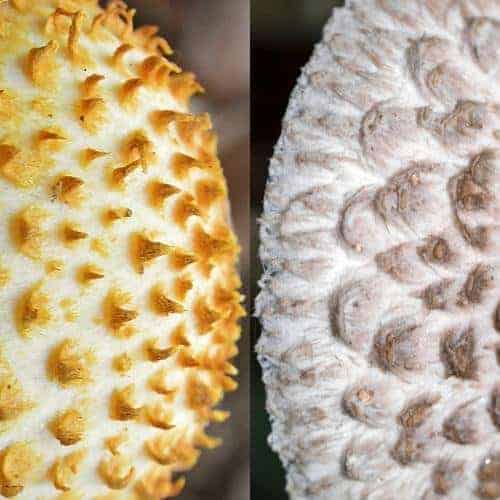
Beneath the cap of many common mushrooms, you’ll find either gills (also known as lamellae), pores, ridges, or teeth. These are the parts of a mushroom’s anatomy that produce and release spores [1].
These parts of a mushroom are important for identification because many species look similar based on the appearance of their cap. The underside of a mushroom is sometimes the only way to distinguish between edible mushrooms and poisonous ones.
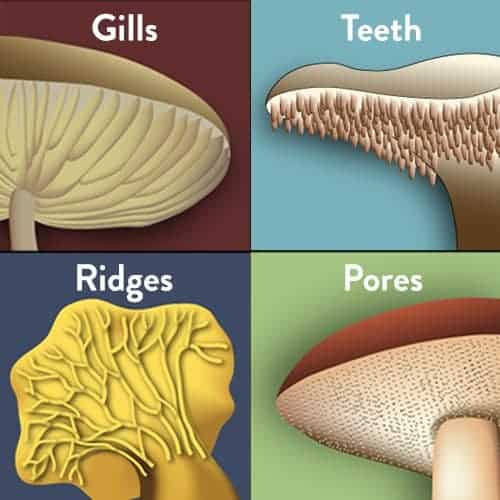
The mushroom gill is a small, thin-walled structure that surrounds the mushroom's stem. It has an opening on one side and is usually found in clusters around the stem.
The gills are composed of two layers: the lamellae that reach from the stem to the edge, and the lamellulae that are shorter gills that don’t reach the stem. Keep in mind that not all mushrooms possess lamellulae [3].
Gills can have many distinct characteristics that can help identify a mushroom, such as:
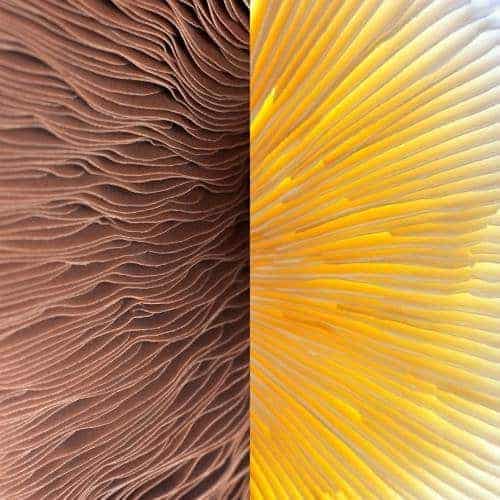
Gills can be attached to the stem or free, where the gills never reach or attach to the stem. They can also have various forking or branching patterns. When it comes to identification, knowing the difference between true gills and false gills can be very helpful.
Keep in mind that forking gills can be deceptive. For instance, chanterelle mushrooms have structures that look similar to forked gills, but these are actually false gills.
False vs True Gills: False gills often appear as smooth ridges underneath the cap. True gills, on the other hand, are separate parts of a mushroom that can be picked off.
There are mushrooms with undersides that look deceptively similar to gills. As mentioned in the previous section, these false gills are actually ridges.
One test for figuring out whether a mushroom has ridges or gills is to try and detach them from the mushroom.
You most likely have a gilled mushroom if you can easily pull a segment off the underside away from the cap. If the ridges seem to mold into the mushroom itself and cannot be easily detached from it, your mushroom most likely has ridges (false gills).
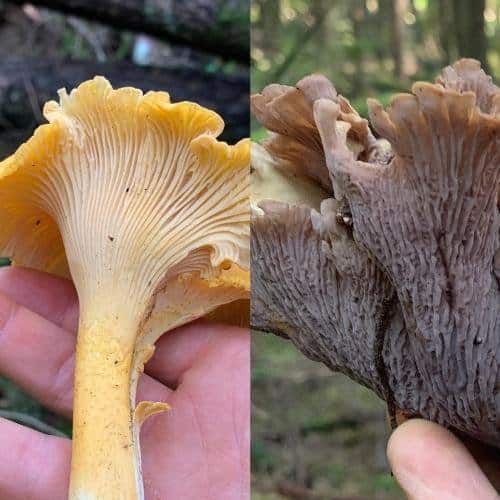
Other types of mushrooms have pores instead of gills. Like gills, pores produce spores, but they appear as small, sponge-like holes instead of thin blades.
The little holes lead to tubes inside the cap. As spores mature, they eventually fall from the tubes out of holes and into their environment.Similar to gills, these mushroom parts help indicate the species. Color, size, pattern, and quantity are all pore traits that help determine the identity of your mushroom sample.
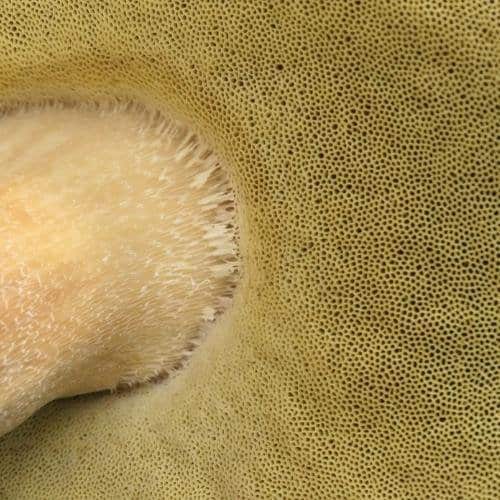
Boletes and polypores are two common types of mushrooms known to have pores.
Boletes grow in deciduous and coniferous forests by making symbiotic relationships with trees. Polypores, on the other hand, are almost always found growing on rotting wood.
Turkey tail is an example of a polypore. They are a type of healthy mushroom that grow flat off the sides of decaying wood and fan out as they mature. As they grow, they develop rings of different shades of brown and white that make them resemble a turkey’s tail.
Like the turkey tail, other polypores are usually shelf-shaped and non-poisonous.

Mushroom teeth are long, thin, shaggy growths hanging from the mushroom cap. They can be a few millimeters to a few centimeters long.
These teeth, also known as spines, make it easier to narrow down the species of mushroom because they’re features that are not as present compared to gills or spores.
Some fungal organisms with mushroom teeth:
As noted before, lion’s mane mushrooms (also called bearded tooth mushrooms) also have teeth, but theirs grow from their stem, whereas other mushrooms would have a cap.
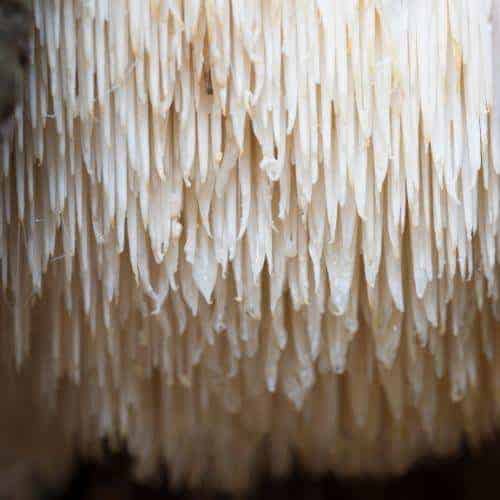
The microscopic reproductive cells that make it possible for fungi to replicate are called spores.
Just like plants need seeds to reproduce, mushrooms need spores. If the visible mushroom is the “fruit,” the spore is the “seed.” Spores are found under the mushroom cap, within the gills or pores [1].
Spores are unique in that they can form into a new mushroom without needing to fuse into another reproductive cell.
There are no male or female spores because mushrooms typically reproduce asexually. However, they do have the ability to reproduce sexually when two compatible mycelia clumps fuse [2].
Mushrooms can release trillions of spores every day, but they don’t produce spores all the time. They will only create spores if conditions are ideal. Mushrooms need ample nutrients and water to produce spores and carry out their life cycle [2].
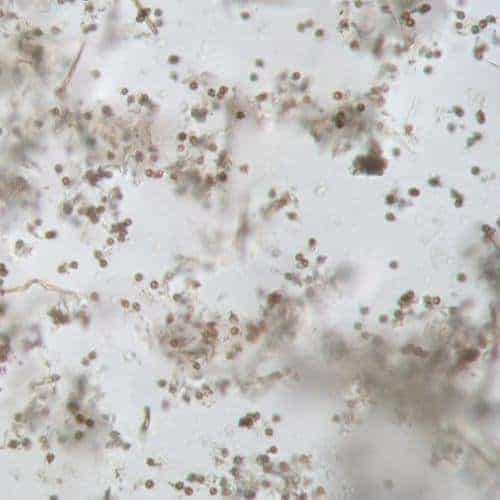
Mushrooms have developed many creative and fascinating methods for dispersing their spores.
Some simply drop or eject their spores from their gills, pores, or teeth, allowing critters, water, or a light breeze to carry them off to their new destination. If they’re lucky, they’ll fall onto the fertile ground and restart the mushroom life cycle [4] [5].
Some have evolved in interesting ways to encourage maximum spore dispersal, such as the common puffball, stinkhorn, and chaga mushrooms.
The Lycoperdon perlatum, also known as the common puffball, is one of them.
They have one large pore at the top of their cap for releasing spores. When something bumps into them, like raindrops or small animals, a large number of spores are ejected in a smoke-like cloud [4] [5].
On the other hand, the stinkhorn is a mushroom that works with insects to disperse their spores. This mushroom has a very pungent smell that attracts flies, ants, and other bugs.
It also secretes a sticky slime containing its spores. When insects crawl all over them, the slimy spores inevitably get stuck to them, and they carry them off to a new destination [6].
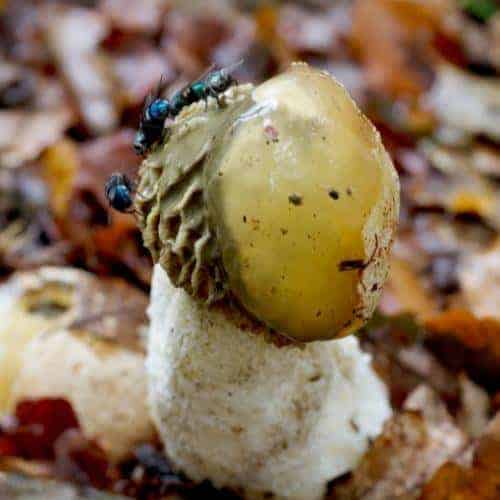
Interestingly, chaga is a fungus that grows on birch trees and has no reproductive spores.
Instead, its spores develop underneath the tree's bark and accumulate around the chaga conk as the tree dies. From there, the spores disperse into the air, so each mushroom spore lands on new trees to grow in.
A mushroom stem is the stalk of a mushroom, also sometimes referred to as the stipe. Its primary function is to support the cap and the spores it contains.
This part of a mushroom is long, sturdy, and shaped like a cylinder. The stem usually has an annulus or volva attached to it. These parts of a mushroom protect the spores during development [7].
When some mushrooms are in the early stages of growth, they develop a partial veil that surrounds and protects the underside of the cap.
As the mushroom matures and expands, its partial veil breaks away from the cap and is left hanging around the stem. This hanging part is the annulus, or mushroom ring [7].
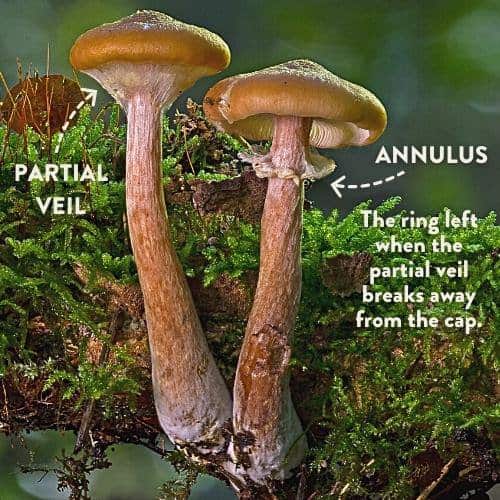
Other types of mushrooms also have a universal veil that encapsulates the entire mushroom during early development.
As the mushroom matures, the universal veil breaks off. The pieces of the universal veil that remain attached to the bottom of the stem are the volva [7].
Fragments of the universal veil often stick to the cap in patches, resembling warts. For instance, Amanita Muscaria’s white spots are fragments of its universal veil.
Both Veils: Usually, mushrooms with a universal veil also have a partial veil. If both parts of a mushroom are present, they will have a volva and an annulus.
Mycelium, an unseen but fascinating part of mushroom anatomy, consists of small networks of threads called hyphae. These have the primary function of collecting nutrients and water.
Environmental conditions need to be just right for the mycelium to produce a mushroom. Some mycelium can live for hundreds, even thousands of years, without producing a mushroom.
Interestingly, all mushrooms come from mycelium, but not all mycelium will produce mushrooms [1] [2].
Mushrooms are not plants and don't have roots like most plants do. However, mycelium is often referred to as the mushroom’s root system because it behaves similarly.
Like plant roots, mycelium's role is to collect valuable resources and keep the mushroom anchored to the earth. But mycelium is different in that it secretes enzymes to break down and absorb surrounding dead, organic matter. This process of decomposition makes fungi crucial for the health of our environment [2].
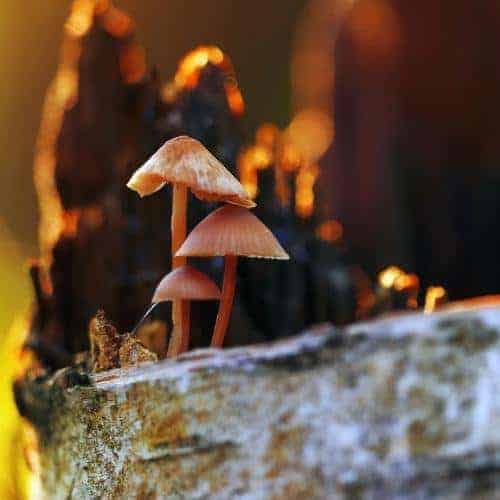
The smaller, individual branching units that make mycelium are called hyphae. This part of a mushroom develops when a spore is carried to the fertile ground, where it can germinate and shoot out tiny, filamentous hyphae strands [1] [2].
These hyphae strands grow as they collect food and nutrients and eventually contact and combine with other hyphae. The collective unit of these ever-growing networks of hyphae is referred to as mycelium [2].
Each part of a mushroom’s anatomy is equally important for supporting the life cycle of a fungus. But is each component equal when it comes to the health benefits it can provide humans?
Functional mushrooms such as reishi, lion’s mane, cordyceps, turkey tail, and chaga contain various nutrients and compounds that can be beneficial in supporting your health. Most of their key health benefits come from their polysaccharide content, particularly beta-glucans.
Studies show that beta-glucans can help balance your body’s immune response, support healthy blood sugar levels, and affect energy levels [8] [9].
Data suggests that the abundance of beta-glucans varies when comparing different growth stages and parts of these fungi.
One study showed that the shiitake mushroom (fruiting body) can have up to about twice as many beta-glucans as its mycelium [10]. It was also discovered that the cap and stem of the mushroom contained different levels of beta-glucans.
The chart below shows the significant difference between mushroom (fruiting body), pure mycelium, and myceliated grain in a study of cordyceps beta-glucan content.
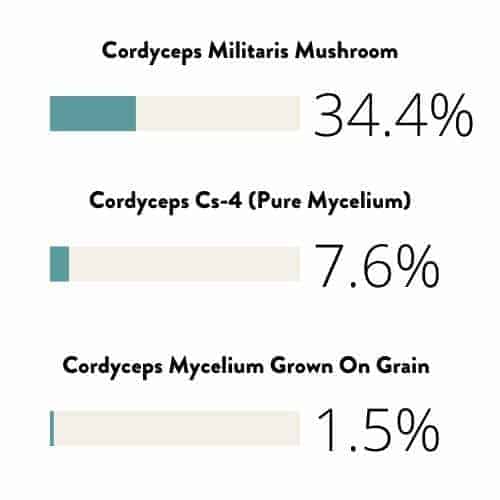
Since most of a mushroom's health benefits come from its beta-glucan content, it would be ideal for mushroom supplements to be made from only the mushroom (fruiting body).
There’s an ongoing problem in the mushroom supplement industry where manufacturers use both the mushroom and mycelium, or only the mycelium. In these cases, the grain substrate the mycelium grows in is not separated out and ends up in the final product.
The result is a supplement with little to no actual mushrooms in it. These products contain unnecessary starch-based filler rather than high concentrations of health-supporting compounds like beta-glucans.

Understanding the parts of a mushroom is an excellent way for identifying mushrooms and their different species. Besides knowing how to differentiate edible mushrooms from poisonous mushrooms, you’ll also have a better idea of their reproductive processes and nutritional benefits.
To be certain that you get the most high-quality mushroom supplement, look for extracts made from only the mushroom (fruiting body). The label of the product should make it clear that it is made using only the mushroom. Ideally, the label will also indicate the percentage of beta-glucans.
Real Mushrooms use only mushrooms in our powder extracts, with our product labels showing exactly what ingredients we include, including the beta-glucan content. Shop confidently, knowing that the mushroom capsules and bulk powders you order are made of 100% organic mushrooms with verified beta-glucans content.
Browse our selection of mushroom extract supplements today.

Disclaimer: The information or products mentioned in this article are provided as information resources only, and are not to be used or relied on to diagnose, treat, cure, or prevent any disease. This information does not create any patient-doctor relationship, and should not be used as a substitute for professional diagnosis and treatment. The information is intended for health care professionals only. The statements made in this article have not been evaluated by the Food and Drug Administration. Any products mentioned are not intended to diagnose, treat, cure, or prevent any disease. The information in this article is intended for educational purposes. The information is not intended to replace medical advice offered by licensed medical physicians. Please consult your doctor or health practitioner for any medical advice.